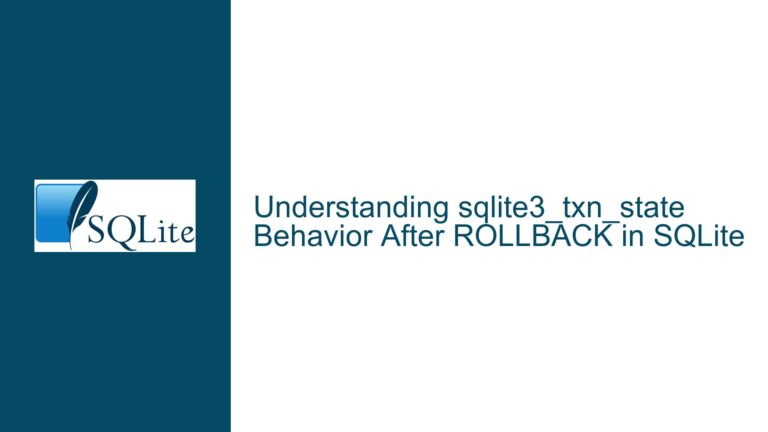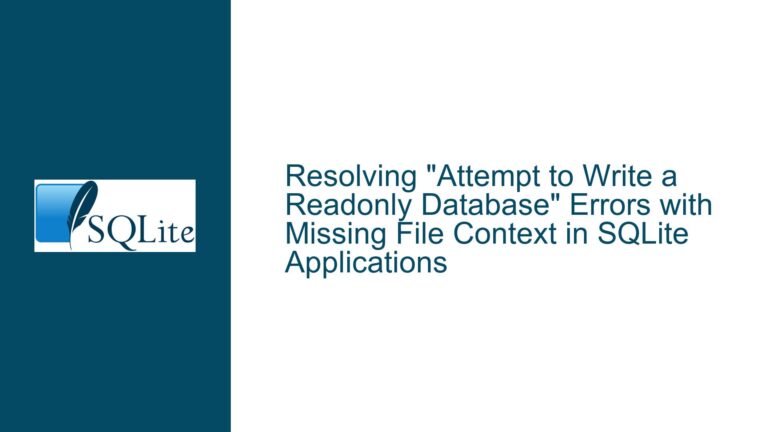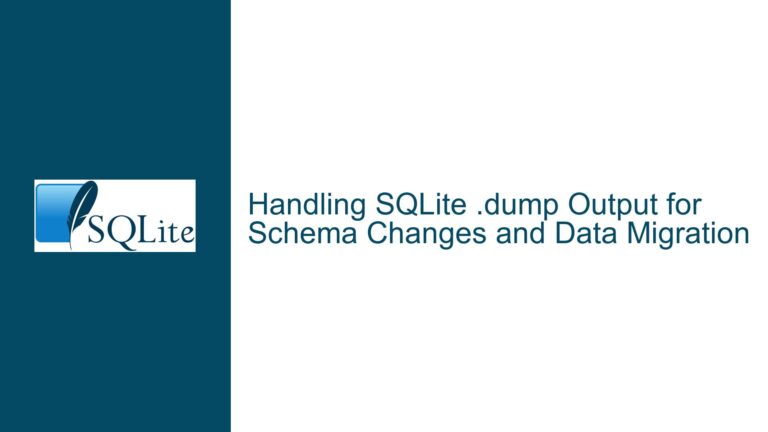and Resolving SQLite CLI Nonce Usage Errors
Issue Overview: Misuse of –nonce and .nonce in SQLite CLI
The core issue revolves around the incorrect usage of the --nonce and .nonce commands in the SQLite Command Line Interface (CLI). The user attempted to replace the --unsafe-testing option with --nonce ABC and .nonce ABC but encountered persistent errors. The primary error message was "Parse error: unsafe use of p2()", which indicates that the custom function p2() was being blocked by SQLite’s safety mechanisms.
The user’s initial approach was to use --nonce ABC at the command line and apply .nonce ABC for specific operations, such as loading an extension DLL and executing a query. However, none of these attempts succeeded, leading to the conclusion that either the documentation was misunderstood or there was a bug in the implementation.
Possible Causes: Misalignment Between –nonce and –safe Options
The root cause of the issue lies in the misunderstanding of how the --nonce and .nonce commands interact with the --safe option. The --nonce and .nonce commands are designed to disable the protections added by the --safe option. If --safe is not used, then --nonce and .nonce have no effect. This is a critical detail that was overlooked in the initial attempts.
Another layer of complexity is introduced by the PRAGMA trusted_schema setting. This pragma controls whether SQLite trusts the schema to be safe for certain operations, such as loading extensions or executing custom functions. When PRAGMA trusted_schema is set to OFF, SQLite will block the use of custom functions unless they are marked with the SQLITE_INNOCUOUS flag. This is likely why the custom function p2() was being blocked, even when --nonce and .nonce were used.
The user also attempted to use --unsafe-testing, which disables a different set of protections unrelated to those added by --safe. This further complicated the situation, as the user was trying to replace --unsafe-testing with --nonce, not realizing that they serve different purposes.
Troubleshooting Steps, Solutions & Fixes: Correct Usage of –nonce and .nonce with –safe
To resolve the issue, the user needed to correctly align the use of --nonce and .nonce with the --safe option. Here are the detailed steps to achieve this:
Step 1: Start the SQLite CLI with –safe and –nonce
The first step is to start the SQLite CLI with both the --safe and --nonce options. This ensures that the protections added by --safe are in place, and --nonce can be used to selectively disable them.
D:\sandbox>sqlite3.exe --safe --nonce ABC MW_2023_2.sqb
Step 2: Use .nonce to Load the Extension DLL
Once the CLI is started with --safe and --nonce, the next step is to use .nonce ABC to load the extension DLL. This temporarily disables the protections added by --safe for the .load command.
sqlite> .nonce ABC
sqlite> .load SQLite3.dll
Step 3: Execute the Query Without Additional .nonce
After loading the extension DLL with .nonce ABC, the user can execute the query without needing to use .nonce again. The protections disabled by .nonce ABC remain disabled for the duration of the session, allowing the query to run without errors.
sqlite> select * from My_idea;
Step 4: Verify the PRAGMA trusted_schema Setting
If the above steps do not resolve the issue, the user should verify the PRAGMA trusted_schema setting. This can be done by executing the following command:
sqlite> PRAGMA trusted_schema;
If the result is 0, then PRAGMA trusted_schema is set to OFF, and SQLite does not trust the schema. In this case, the user can temporarily set PRAGMA trusted_schema to ON to allow the use of custom functions.
sqlite> PRAGMA trusted_schema=ON;
Step 5: Mark Custom Functions as SQLITE_INNOCUOUS
If setting PRAGMA trusted_schema to ON is not desirable, the user can mark the custom function p2() as SQLITE_INNOCUOUS. This flag tells SQLite that the function is safe to use, even when PRAGMA trusted_schema is OFF.
SQLITE_API void sqlite3_extension_init(
sqlite3 *db,
char **pzErrMsg,
const sqlite3_api_routines *pApi
){
sqlite3_create_function(db, "p2", 1, SQLITE_UTF8 | SQLITE_INNOCUOUS, 0, p2_func, 0, 0);
}
Step 6: Recompile and Reload the Extension DLL
After marking the custom function as SQLITE_INNOCUOUS, the user needs to recompile the extension DLL and reload it using the .load command.
D:\sandbox>sqlite3.exe --safe --nonce ABC MW_2023_2.sqb
sqlite> .nonce ABC
sqlite> .load SQLite3.dll
sqlite> select * from My_idea;
Step 7: Test the Query Again
Finally, the user should test the query again to ensure that the issue is resolved. If everything is set up correctly, the query should execute without any errors.
sqlite> select * from My_idea;
By following these steps, the user can correctly use the --nonce and .nonce commands in conjunction with the --safe option to bypass SQLite’s safety mechanisms for specific operations. This approach ensures that the custom function p2() can be used without encountering the "Parse error: unsafe use of p2()" error.
Conclusion
The key to resolving the issue lies in understanding the relationship between the --nonce, .nonce, and --safe options, as well as the role of the PRAGMA trusted_schema setting. By correctly aligning these options and settings, the user can selectively disable SQLite’s safety mechanisms for specific operations, allowing the use of custom functions and extensions without compromising the overall security of the database.






